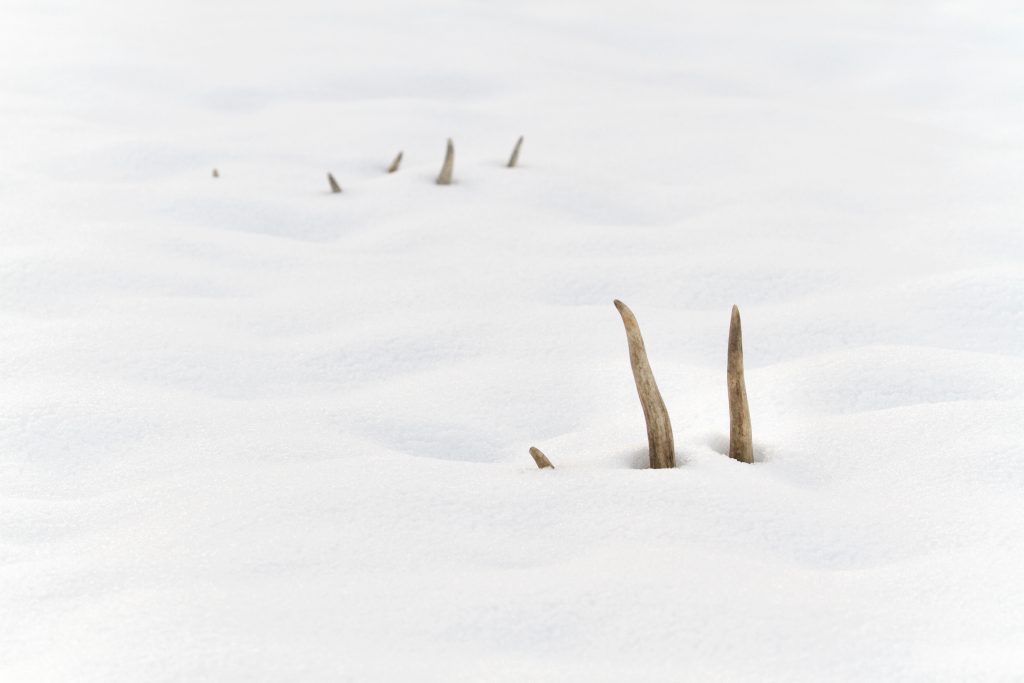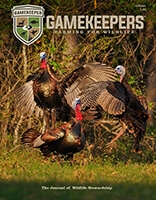Looking to find more shed antlers this season? Shed hunting is one of the most overlooked scouting tools for whitetail deer hunters. These shed hunting tips will help you maximize your success and uncover what bucks survived the winter.
As I write this, a lot of hunters are anxiously waiting on whitetails to drop their antlers, by the time it’s published they will have been cast. While others might only be interested in killing deer on those crisp November days we all dream about. It’s debatable whether shed hunting will help you kill a deer in the fall but I do know this, if you find a shed from a buck, he was there for a reason and you should take note. But, if you take too much stock in where you find a shed in the spring, or don’t understand the fall vs winter needs of a whitetail, shed hunting can mislead you.
If you don’t shed hunt, I think you should. There is a lot to learn on an overcast day in March when melting snow reveals the secrets of last fall. If you think shed hunting in the spring is a good way to scout, you should try scouting in-season during the fall months, obviously without putting too much pressure on an area. But let’s be honest, the majority of us are terrified to walk around our woods mid-day during October and November at the risk of spooking our target deer.
So, many hunters are left with the days of February and March to pull double duty and uncover last fall’s deer sign and find those big sheds from the bucks lucky enough to have survived the winter thus far. If you want to fine tune your shed hunting methods and find the most “bone,” here is how to do it.

Linda Arndt
When Do Bucks Shed Their Antlers? Wait for the Right Time
You can’t find sheds if bucks are walking around with them still on their head. If you are a hardcore shed hunter, you should have trail cameras out to keep tabs on bucks. Not only will you be able to tell when most have dropped, you’ll get insight into where bucks on your land are spending the most time. It’s easy to jump the gun and start walking your entire land when you feel cooped up from the cold of winter. But you need to hold off if you want to find a high number of antlers.
Keeping trail cameras on a trail system near food will likely catch deer transitioning from bed to food and vice versa. Personally, in my area I do not find winter travel routes to vary much from fall, but I hunt in hill country where terrain dictates much of the travel. Travel routes are something you’ll need to figure out because in some areas they can vary greatly from fall depending on terrain and food availability. Using trail cameras to find where deer are spending time is critical.
Can You Shed Hunt in Snow? Why Timing Matters

Tom Reichner
I don’t play the lottery, but I liken finding shed antlers in the snow to winning a few greenbacks while playing the lottery. Sure, you can find sheds in the snow—but it’s a frustrating experience and you lose more times than not.
There are exceptions. If you have a great late winter food source that concentrates deer like standing soybeans, corn, or a brassica plot, then you stand a decent chance at finding sheds in the snow over a condensed area. Many shed hunters get fooled into thinking deer will be in a certain food source all winter long – and that isn’t always the case. Deer can move and bed in a wide range of places based on warm spells, bouts of snow melt, food sources changing or other factors.
Deep snow may occur at times throughout the winter months, but if a majority of the snow melts during prime antler shedding weeks, then its important you understand bucks may then return to food sources like clover or even browse inside the timber on a south slope and your search area can increase significantly.
Best Weather Conditions for Shed Hunting

Linda Arndt
Shed hunting after a rain on an overcast day is easy on the eyes and helps the sheds pop against darkened leaves. I love soaking in the sun and walking on a March day, but bright sunny days can make it difficult to see and find sheds.
If luck doesn’t allow you shed hunt during or after a light rain or on an overcast day, get up right away in the morning to search prime bedding areas before the mid-morning sun impedes your vision, or during what is often called the golden hour (the last hour of sunlight of the day). The sun’s angle and its golden tint will make sheds pop. Scour those prime bedding areas and food sources right away. Take a shed you’ve already found and toss it out in front of you a few times to train your eyes again.
Why South-Facing Slopes Hold More Shed Antlers
Yes, here is another shed hunting article telling you to spend a lot of time on those south facing slopes! I wouldn’t be writing about it if it didn’t work. Remember, deer have to work every single day just to stay alive. They have to gain every advantage they can during late winter, and basking in the sunshine saves energy and aids in that process.
South facing slopes are also the first areas where snow melts. Even in bitter cold temperatures, the late winter sun can be quite strong and will slowly melt off southern slopes to expose shed antlers.
Take a break and sit down on dry southern-exposed leaves this spring and you will immediately notice the warmth radiating from the ground as compared to a northern facing slope where the sun cannot be found. Some shed hunters will tell you they always find the biggest antlers on northern slopes, I’m not sure this is true, but if you want to find quantities of antlers you need to spend time in warm areas receiving sunlight.
Best Shed Hunting Apps and Mapping Tools

Tes Jolly
Most hunters are now equipped with a smartphone mapping application featuring parcel data and some version of a tracking feature. Tracking features are an excellent way to see where you have walked and find areas that still need your attention. I use the Drury Outdoors DeerCast app, but other good ones include onX Hunt, HuntStand, and ScoutLook.
When walking on a hillside for example, instead of just walking main trails, I like to walk the length of a hillside back and forth advancing higher on the ridge with each pass. If you just stick to trails, you will eventually veer off and go down the rabbit hole of trail hopping and you could miss sheds.
Walk an entire side hill or ridge top if it’s in a prime area using this pattern, and you will probably find sheds in a few odd places within those areas. Deer don’t always stick to trails and they will follow the movement of sun to find a wind and thermal advantage on hillsides.
How Late Winter Food Plots Help You Find More Sheds
I talk to lot of hunters and land managers who plant a lot of food, and they kill big deer on a consistent basis and many of them do not have excellent deer cover. If you asked me whether you should lean heavily into planting food plots or focus on creating the best deer cover, I might just say food plots. That’s a debate for another day. The point is, you need to check the boxes of what deer need this time of year, and deer need food in late winter.
Unless you’ve done recent timber stand improvement or had a logging project completed, optimal deer cover has all but disappeared during the months of February and March. Deer are bedding to gain a thermal and line of sight advantage, while staying as near food as possible. Food is king.
If you can plant more food, do it. Not only will you increase your fall hunting opportunities, you’ll certainly find more shed antlers in the spring if you have food well into winter.
Top Places Where Deer Loose Antlers

Paul Annear
Some of the best places are spots where buck’s antlers might get bumped, shaken or jarred loose. Fence crossings, creek crossings or places where they have to jump, such as over a blowdown, are good places to look. An adult deer can jump six to eight feet high, but have been known to spring-up over ten feet on occasion. That shock can knock a loose antler from their head. Even if they pass under a fence there is a chance their crown may bump a barbed-wire strand.
Wrapping Up
Finding a large number of sheds is all about understanding the needs and behaviors of deer. Much like hunting throughout the fall, you need to be in tune with food, travel and bedding. To those saying spring is a slow time of year for the deer hunter, I disagree! If you’re a shed hunter or a habitat enthusiast, it’s one of the busiest times of the year and a great time to build excitement for the upcoming fall.
Join our weekly newsletter or subscribe to GameKeepers Magazine.
Your source for information, equipment, know-how, deals and discounts to help you get the most from every hard-earned moment in the field.









